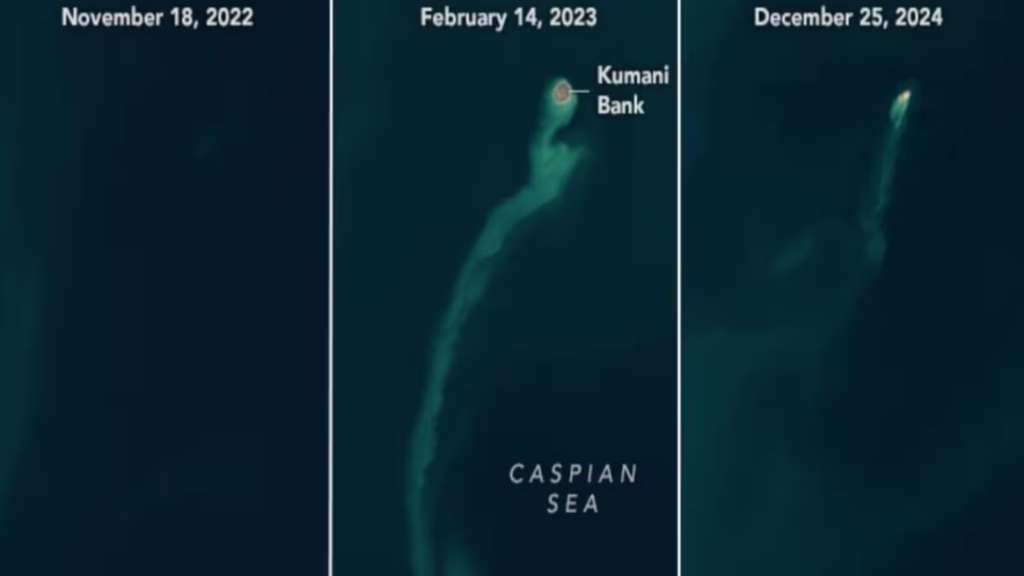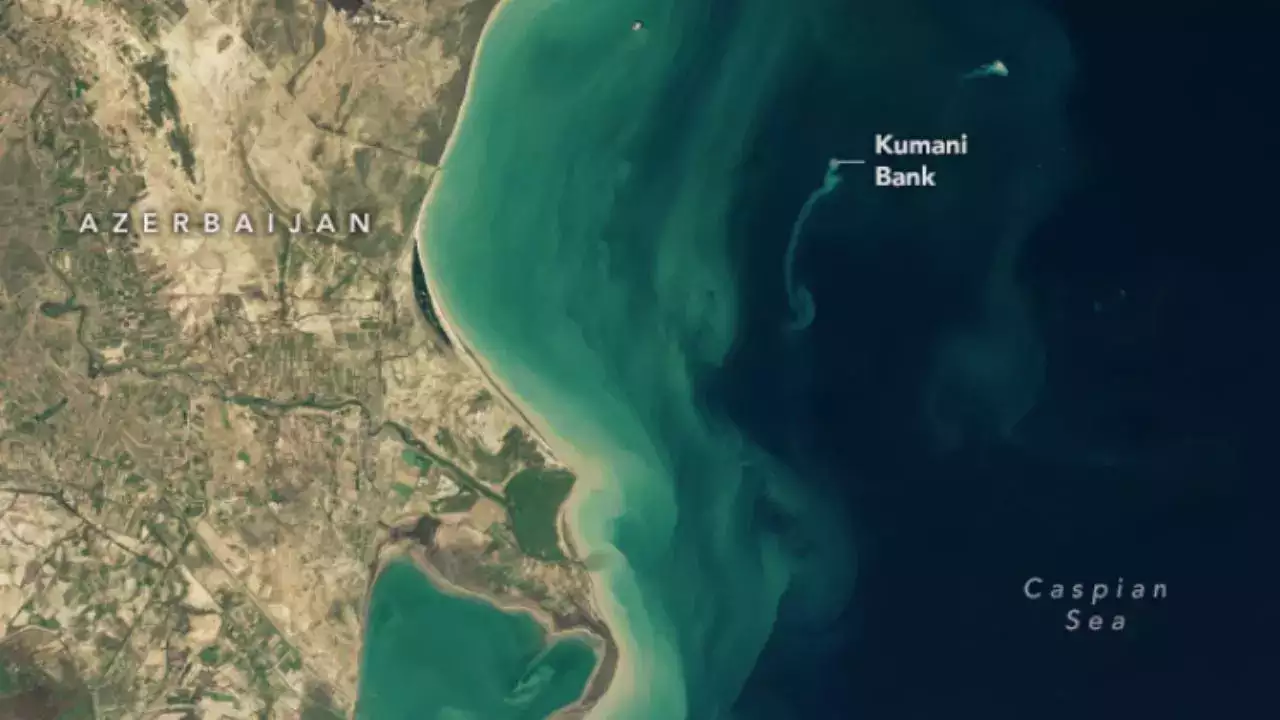In a fascinating display of Earth’s natural forces, a transient “ghost island” emerged in the Caspian Sea in early 2023, only to vanish beneath the waves by the end of 2024.
This temporary landmass, born from a mud volcano eruption, captivated geologists and environmentalists alike, offering a brief yet significant glimpse into the dynamic processes shaping our planet’s surface.
Birth of the Ghost Island: The Kumani Bank Mud Volcano
The emergence of this ghost island was attributed to the eruption of the Kumani Bank mud volcano, located approximately 25 kilometers off the eastern coast of Azerbaijan.
This area is renowned for its geological activity, housing the world’s largest concentration of mud volcanoes. The island’s birth was captured by NASA’s Earth Observatory, utilizing satellite images from the Landsat 8 and 9 satellites.
The first signs of the eruption became evident between January 30 and February 4, 2023. By February 14, a small landmass approximately 400 meters across had risen above the water’s surface. Sediment plumes from the eruption trailed away from the site, vividly illustrating the scale of the event.
Read : Point Nemo: The Loneliest Place on Earth
Geologist Mark Tingay from the University of Adelaide confirmed the formation of this significant landmass, highlighting its unique characteristics and ephemeral nature. Unlike traditional volcanic islands, mud volcano islands are composed of a slurry of mud, gases, and sediments, making them prone to rapid erosion.
Read : Scary places on Earth that most people wouldn’t dare visit
Within months, the ghost island began to erode, and by the end of 2024, only remnants of the Kumani Bank volcano remained visible. The rapid disappearance underscored the volatile and transient nature of mud volcanoes, leaving researchers intrigued by the processes at work.
A History of Transience: Previous Eruptions of Kumani Bank
The Kumani Bank mud volcano has a long history of creating temporary islands, a phenomenon first recorded in 1861. Each eruption of the volcano has yielded islands of varying sizes and durations, with some lasting mere days while others persisted for months or even years.
One of the most notable eruptions occurred in 1950, when Kumani Bank produced an island spanning 700 meters across and rising 6 meters above the water. This eruption remains the most powerful on record, with the resulting landmass enduring longer than most of its predecessors.

Earlier eruptions, such as the one in May 1861, generated smaller islands, like one measuring just 87 meters across and rising 3.5 meters above the sea. This island eroded by early 1862, emphasizing the fleeting nature of such formations.
The repeated emergence and erosion of these islands are hallmarks of mud volcano activity. Unlike traditional volcanic eruptions, which produce solid rock, mud volcanoes expel semi-fluid material that lacks the stability to withstand the erosive forces of waves and weather.
Mud Volcanoes: Earth’s Enigmatic Geothermal Features
Mud volcanoes, such as the one at Kumani Bank, are among the most intriguing geological phenomena on Earth. These structures, which can range in size from a few meters to several kilometers across, form in regions of active tectonic movement or high sedimentation rates.
The process begins when subsurface pressure forces a mixture of fluids, gases, and sediments to the surface. The expelled material often includes methane, which can ignite during eruptions, creating dramatic fire plumes. In the case of Kumani Bank, past eruptions have sent flames hundreds of meters into the air, a testament to the power of these features.

NASA’s Earth Observatory describes mud volcanoes as “weird and wonderful,” noting their potential to provide insights into Earth’s geology and beyond. The Caspian Sea region, in particular, offers a unique laboratory for studying these formations, given its unparalleled density of mud volcanoes.
Azerbaijan, often referred to as the “Land of Fire,” owes its nickname to the fiery eruptions of its mud volcanoes and its abundance of natural gas reserves. The collision of the Arabian and Eurasian tectonic plates beneath this region creates the perfect conditions for frequent and intense volcanic activity.
Links to Other Worlds
The Kumani Bank eruption has implications that extend beyond Earth. Scientists have drawn parallels between mud volcanoes on our planet and similar features potentially found on Mars. In the Martian lowlands, geologists have identified mounds that may have formed through processes akin to those of Earth’s mud volcanoes.
NASA’s Earth Observatory has suggested that studying mud volcanoes like Kumani Bank can enhance our understanding of planetary geology and the possibility of subsurface life. The presence of gas- and liquid-rich sediments on Mars raises intriguing questions about the Red Planet’s geological history and its potential to support life.

While mud volcanoes offer invaluable scientific insights, they also pose significant hazards. The 2023 eruption of Kumani Bank, for instance, expelled large volumes of sediment and potentially flammable gases, underscoring the dangers associated with these events.
Previous eruptions in the region have demonstrated the destructive power of mud volcanoes. In addition to fiery plumes, these eruptions can trigger local environmental changes, disrupting marine ecosystems and altering sediment patterns.
For Azerbaijan, home to more than 300 mud volcanoes, the risks are a constant reality. Yet, the country also benefits from the scientific interest these features generate, attracting researchers and tourists alike to witness their awe-inspiring eruptions.
The story of the ghost island in the Caspian Sea serves as a vivid reminder of the dynamic forces shaping our planet. From its sudden emergence to its rapid disappearance, this ephemeral landmass encapsulates the beauty and volatility of Earth’s geology. As scientists continue to study mud volcanoes, both on Earth and beyond, they uncover new insights into the intricate processes that define our world.
let’s enjoy few years on earth with peace and happiness….✍🏼🙏

